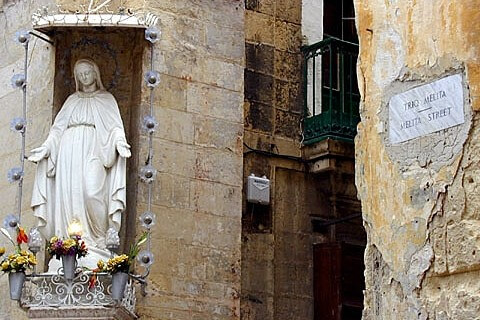Two days after I was married in January of 1994, my bride and I left
our hometown of Cincinnati for New England. I was in between semesters
in my first year of graduate school. With all our belongings stuffed
into a rented powder-blue Taurus Wagon, we drove 15 hours only to be
greeted in Providence, Rhode Island by four feet of snow left behind
several days earlier by one of the decade’s fiercest blizzards.
It was 1:30 in the morning, dark, and 13 degrees when we unloaded
the bulk of our worldly possessions into our three-room, third floor
apartment. Fortunately the snow plows and sidewalk shovellers had
already finished their work. This, we joked, was our honeymoon.
And we’re still joking.
Twelve years later we have five children under the age of eleven.
We’ve finally decided to take a real honeymoon (at some time in the
indeterminate near future), although it looks as if we’ll have a bit a
company this time round.
According to a recent survey published in Modern Bride
magazine, the top five honeymoon spots for American newlyweds are
Hawaii, Florida, Aruba, Jamaica, and Bermuda. The common denominator
here is, of course, sand and surf (and, with the exception of Hawaii,
the distinct possibility of hurricanes or tropical storms from July to
November).
Although my wife Barbara and I both like the seaside in fair
weather, we wondered if we couldn’t find a more suitable destination
for ourselves and other aspiring Catholic honeymoon couples – a spot
with sand and surf, perhaps, but also a place steeped in Catholic
culture, imbued with a rich history, and populated by steeples, domes
and the ringing bells of Christendom.
With Paris burning, Venice sinking, and Rome simply too expensive,
we turned our attentions to less traditional honeymoon destinations in
the heart of Christendom.
Barbara didn’t like my initial idea of exploring the “priest hole”
houses designed and built by St. Nicholas Owen throughout the English
landscape during Elizabethan persecution. Besides, the English south
coast is a bit chilly and the beaches rather too rocky for my taste.
We did, however, take a tip from the English. One of the popular
year round holiday spots for our Anglophone cousins is the archipelago
of Malta. An old outpost of the British empire, Malta is that country
some sixty miles south of Sicily that was long home to the Knights of
St. John, the illustrious military order that defended Europe from
repeated jihad attacks of the Turks.
You’ll not likely find accommodations with circular water beds,
heart-shaped pillows and ceiling mirrors, but if you can do without the
kitsch amenities of commercialized honeymooning, there’s plenty of
Mediterranean waterfront to go around for both bride and groom. Sun and
surf abound, yes, but in Malta you can also soak up history and a good
bit a Catholic culture. In fact, unlike in Paris, Venice or Rome (the
most popular European honeymoon destinations for Americans), Malta is
home to a thriving Catholic population that still takes its faith
seriously.
The islands of Malta and Gozo boast 365 Catholic churches, the vast
majority stunningly beautiful. Many are filled each day, not with
tourists clicking photos for the memory books, but with men and women,
young and old, attending Mass, standing in confession lines, and
praying their devotions.
A good number of them, including St. John’s Co-Cathedral in the
capital city of Valletta, were commissioned by the Knights during the 16th and 17th
centuries under Italian-trained masters such as Lorenzo Gafa, which
accounts for the Baroque feel of the islands. In addition to churches,
the patrimony of the Knights of St. John also includes the walled
cities of Mdina and Victoria, Fort St. Angelo in Birgu, and Ft. St.
Elmo at the tip of Valletta as well the grand auberges, where the
Knights once resided in common life according to their native language:
Auvergne, French, Aragonian, Castillian, Italian, German, and (before
the Reformation of Henry VIII) English.
Incidentally, anyone planning to visit Malta would do well to read
about the “great siege” of the islands by the Turks in 1565. The
Knights, led by Grand Master Jean de la Valette, after which the
capital city is named, defended Malta against 40,000 Muslim corsairs
whose only objective was to slaughter Christians in the name of Islamic
jihad. By defending the islands, the Knights and the native Maltese,
are credited with stopping Islam from moving on northward to conquer
Christendom.
For those newlyweds looking to honeymoon this time of year, you’ll
be glad to know that Christmas is still very much a religious festivity
in Malta. You'll find elaborate nativity scenes, displays of cribs,
carol services and parish parades. On Christmas eve, most parishes have
a procession of Mary and Joseph figures riding on a donkey through the
village streets while children follow them singing carols.
The Baroque parish churches across the islands are just as
awe-inspiring during Advent. Their interiors are decked out in papal
crimson and altars are adorned with flowers. The facades are
illuminated with thousands of lights that spread out into the adjoining
streets. But one thing you won’t find in Malta is a white Christmas.
Even in December the winter sun is still warm and the weather
relatively dry.
On top of all this, Malta is relatively inexpensive by European and
American standards -- for the price of one night in Rome, you could
spend a week in Malta – the Maltese are very friendly people, and
everyone speaks English.
I know many of you still need to work on the “getting married” part,
but when the time comes, why not consider trading those pina coladas
and umbrella swish sticks for the Baroque landscape of (arguably) the
world’s most Catholic country?


